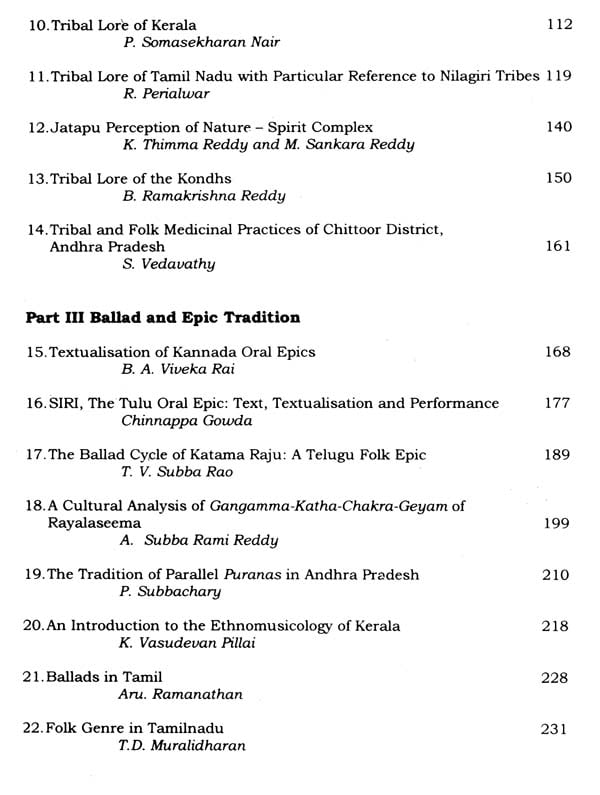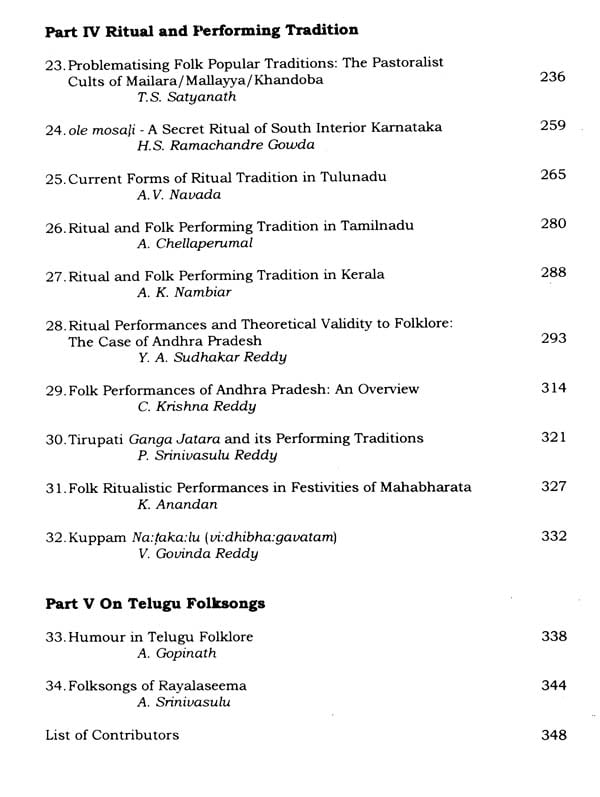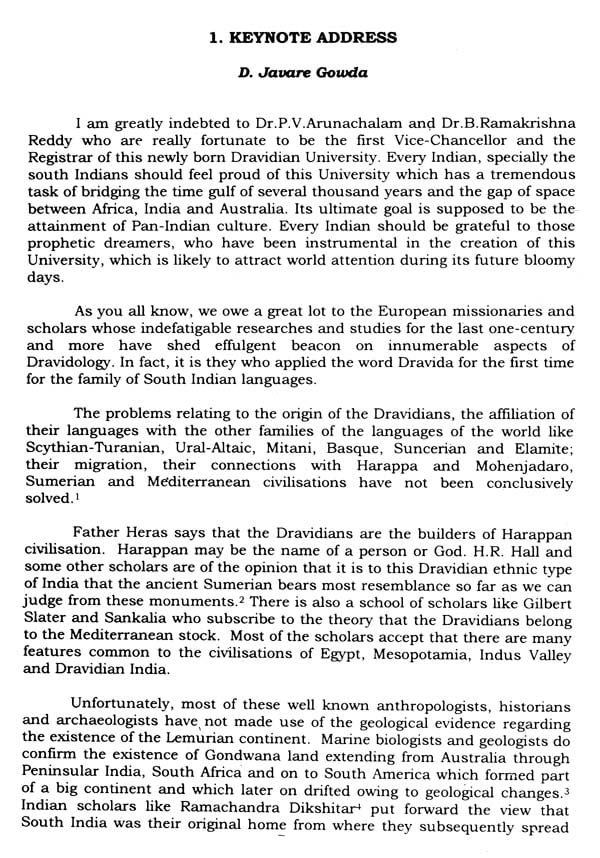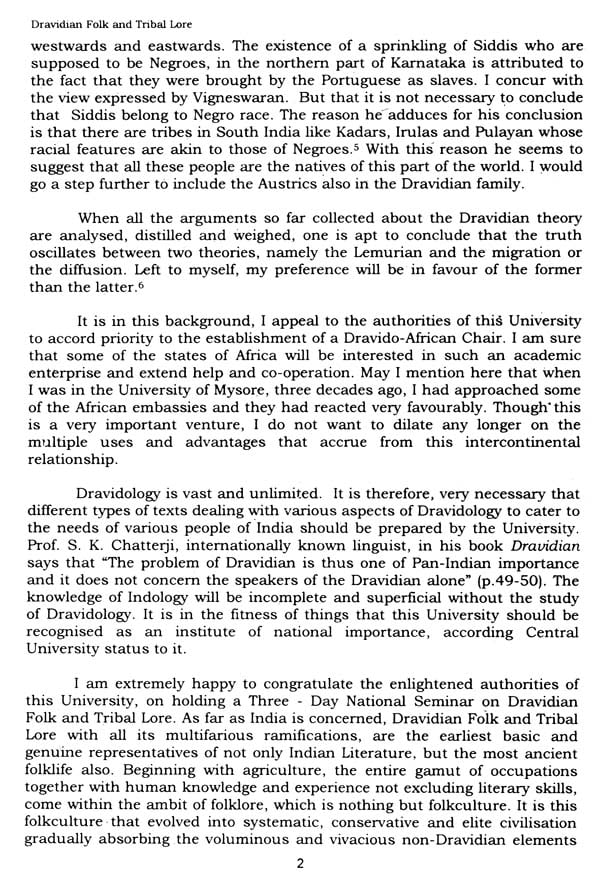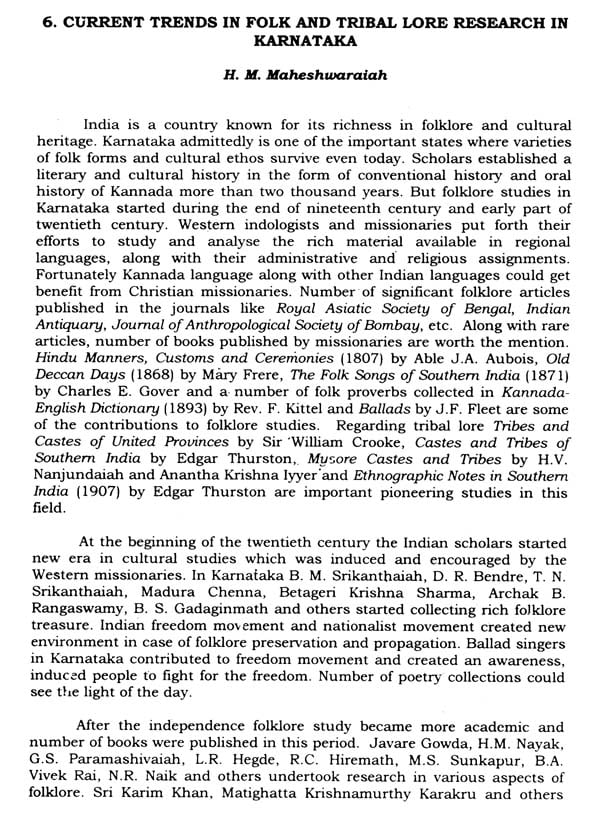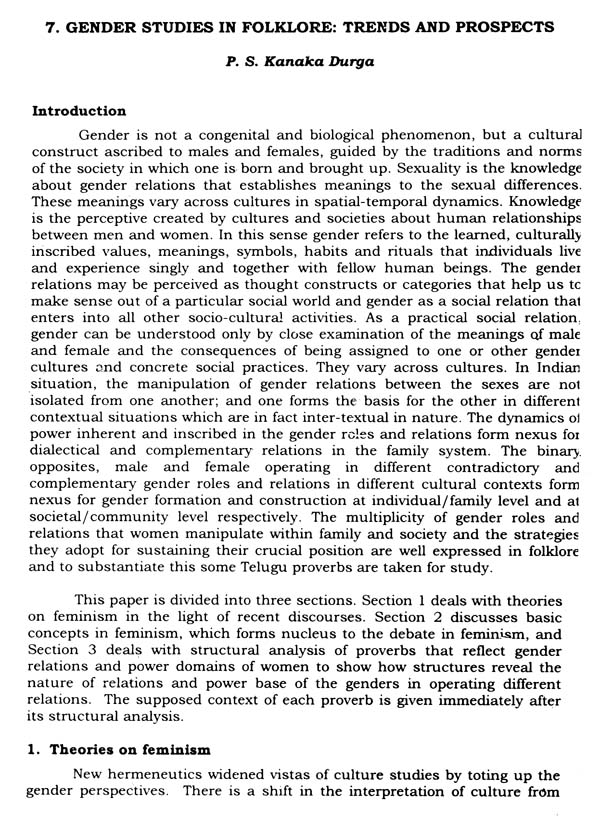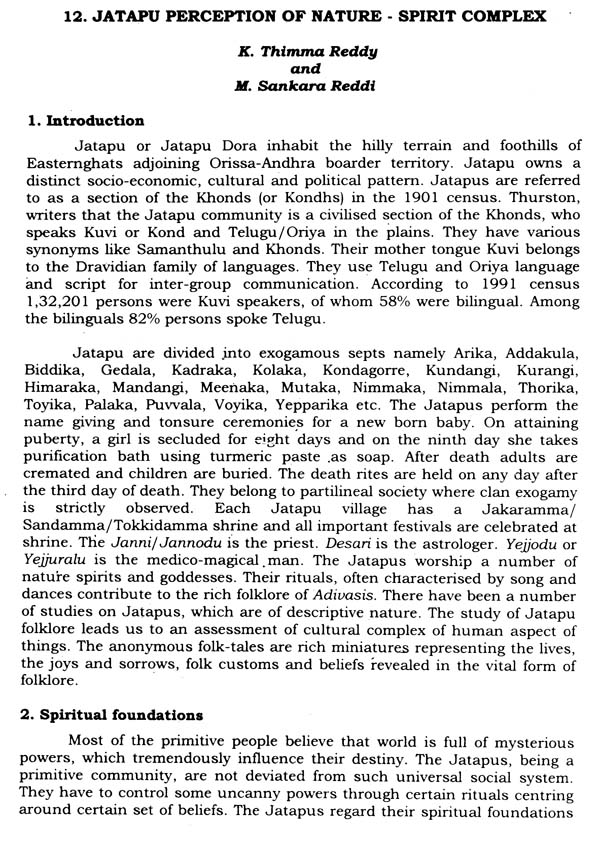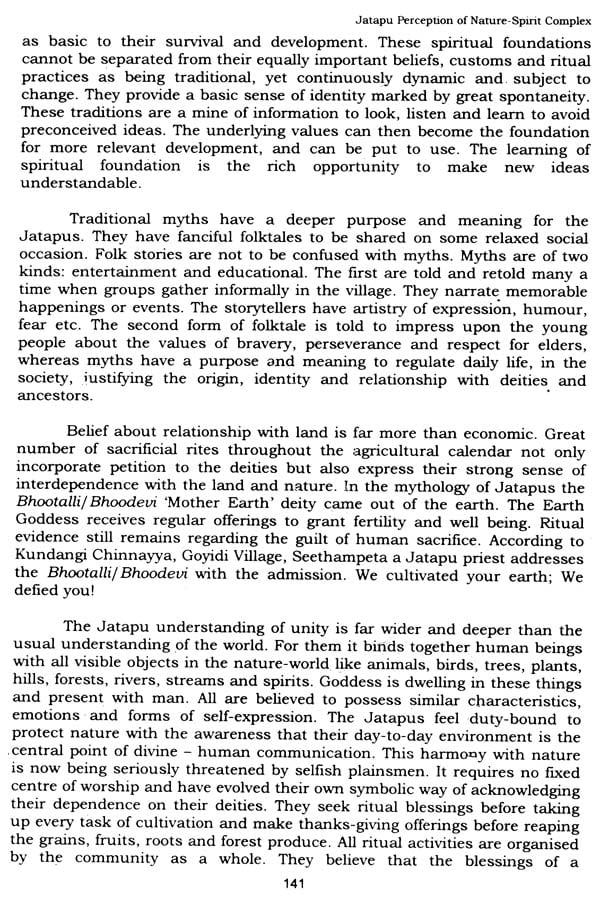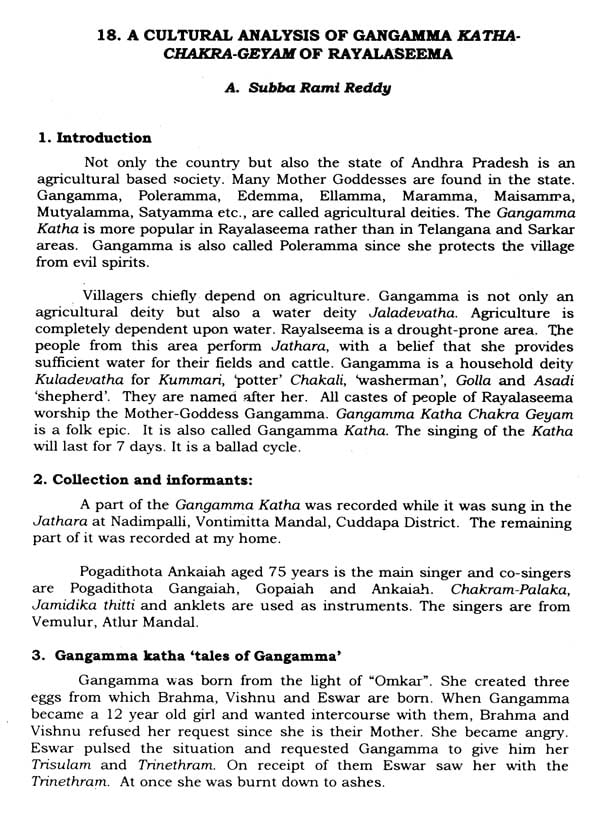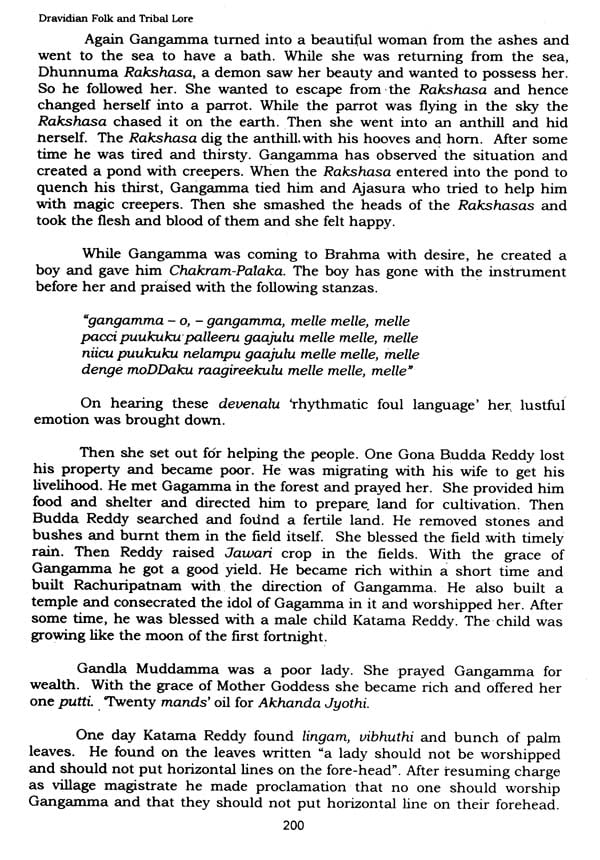
Dravidian Folk And Tribal Lore
Book Specification
| Item Code: | NAX334 |
| Author: | B. Ramakrishna Reddy |
| Publisher: | Dravidian University Campus |
| Language: | English |
| Edition: | 2001 |
| Pages: | 349 |
| Cover: | HARDCOVER |
| Other Details | 11.00 X 9.00 inch |
| Weight | 1.15 kg |
Book Description
The Dravidian University conducted a Three-day National Seminar on Dravidian Folk and Tribal Lore during 8-10 May 2000. About thirty five scholars representing Andhra Pradesh, Karnataka, Kerala, Tamilnadu and other states participated in the Seminar, presented their papers and took part in the discussions. The objective of the Seminar was to project a comparative Dravidian Folk and Tribal Studies with particular reference to the speakers of Dravidian languages. The broad area of folk and tribal lore is divided into five themes namely, (1) Folklore research in South India (2) Tribal Lore (3) Ballad and epic tradition (4) Ritual and performing tradition and (5) On Telugu folksongs. Each part consists of several articles focussing on the thrust area of the Seminar. Prof. D.Javare Gowda in his Keynote Address highlighted the point that folkloristics is ultimately a comparative subject and pleaded for undertaking studies in comparative. Dravidian folkloristics. Prof. P.V.Arunachalam in his Presidential Address stressed the importance of folklore studies and its various branches for culture studies with examples from Telugu proverbs.
In part one the scholars have unearthed the concepts and characteristics of current folklore research in Karnataka, Kerala, Tamilnadu and Andhra Pradesh. This survey is a panorama of efforts and ideas that have gone into folklore research for over more than a century. Recognition of folklore in South India started with the European missionaries, scholars and administrators, during the 19th century. It was fortunately taken up by the native scholars and continued to the present day accommodating the trends in folklore across the world. The importance of gender studies in folklore and its application to a detailed analysis of Telugu proverbs concerned with the household relation of mother-in-law and daughter-in-law is well depicted here which is a thought provoking contribution to women's studies.
The studies dealing with the tribal lore have undertaken such characteristics as ethnolinguistic perspectives, sociocultural aspects, perception of nature - spirit complex and tribal medicinal practices. The folk literature of the Kondh tribes consisting of the speakers of Kui, Kuvi, Pengo, Manda, Indi-Awe and also the other sections of the Kondhs like Samantas and Jatapus are concerned with the communities spread over Northern Andhra Pradesh and Southern Orissa. The sociocultural aspects of Karnataka tribes are depicted in an empathetic tone detailing with their joys and sorrows, difficulties and comforts of life and their meagre way of life under the onslaught of dominating outsiders and the government agencies. It is felt that the tribal culture on Westernghats is endangered under the circumstances. The tribal lore of Kerala covers linguistic as well as ethnic aspects as incorporated in tribal stories. The tribal people of Tamilnadu with particular reference to Nilagiri and their sociocultural aspects as revealed in tribal songs are well brought out with copious examples. The herbal medicines practised by the Yanadi tribes of Chittoor district and the importance of that practice is stressed and it is suggested that the tribal medicines are much more useful and less harmful than the allopathic medicines. The point is that certain aspects of the medical treatment are incorporated into the folk songs of Telugu as detailed in the paper. By and large, the tribal lore retains the ancient Indian culture and heritage in the ordinary genres such as tribal songs, stories, origin-myths, proverbs, riddles, charms and jokes.
Under ballad and epic tradition, scholars have given various dimensions of the subject covering almost the entire South Indian practices. The topics dealt with include textualisation of oral epics, the Siri performances and textualisation, the ballad cycle of Katama Raju, Gangamma Katha of Rayalaseema, the origin-myths of each caste as perpetuated by the folk singers, the importance of ethnomusicology in folk literature, the ballads and folk genres: These topics show the multifarious ways of expressing the underlying conceptual, spiritual and socio-psychological factors in the form of epics, performances and various themes in the folklore.
The papers under the section ritual and performing tradition go into the details of various pastoralist cults, secret rituals, current forms of ritual performances in Tulunadu, Karnataka, Tamilnadu, Kerala and' Andhra Pradesh. The rituals and performing traditions depicted here include the worship of village deities, both male and female, the secret rituals where outsiders are not allowed, different kinds of serpent worship, the folk performing arts lile Therukuttu, Veedhinatakam, Yanadi dances and various other dance forms and rituals related to Mahabharata and Ramayana. These rituals indicate the people's attachment to the land, their dependence on the nature and their spiritual and mental makeup.
The final section consists of two papers on Telugu folksongs describing the rural life of Rayalaseema. These songs are both hilarious and pathetic. Thus the volume represents the current research on different aspects of South Indian folklore and tribal lore. Folklore by its very nature is a multidisplinary subject drawing new ideas and current trends from different areas of research in Humanities and Social Sciences. This fact is well represented in the present volume as it contains contributions by folklorists, literary critics, writers (in South Indian languages), educationists, anthropologists and linguists. Scholars from these disciplines have started examining folklore data from different perspectives, which is a welcome trend for the growth of Dravidian folk and tribal lore.
We have tried our best to assemble the top specialists in Dravidian folk and tribal lore in order to make available their current research to the public at large. We are painfully aware that there are many areas of folk and tribal lore, which are left out here. Moreover, the present volume is extensive in its coverage but there is a need to undertake an intensive research on theme-oriented thrust areas within the field. However, the ideas, concepts and notions expressed in each and every paper represent the concerned author's thinking and not the editor's. We shall feel happy if our effort contributes to the advancement of ideas in research on Dravidian folk and tribal lore. It is for the scholars to use and criticise the volume, and to suggest us for further improvements.
I have great pleasure in presenting this volume of research papers on Dravidian Folk and Tribal Lore to the research scholars. This is a valuable collection of thirty five papers presented in the National Seminar on Dravidian Folk and Tribal Lore conducted by the Dravidian University, Kuppam during 8-10 May 2000.
Study of Folk and Tribal Lore, for some reasons, had no place in the Universities in the past. It is only in recent times, with continuous efforts of the folklorists like Prof. Javare Gowda, Prof. H. M. Nayak, Prof. Hiremutt and Prof. B. Rama Raju that the subject could get its due place in Universities. The subject which was taught as one of the optional courses at the M. A. level has now attained the status of an independent discipline in many Universities. The study of the Dravidian Folk and Tribal Lore will immensely help in proper' understanding of the Dravidian Culture and Heritage. I hope the learned papers of the scholars printed here have discussed all important aspects of Dravidian Folk and Tribal Lore.
I thank Prof. P. V. Arunachalam Former Vice-Chancellor of Dravidian University under whose able guidance the Seminar was conducted and efforts have been made for the publication of the Seminar Proceedings.
I thank Prof. B. Ramakrishna Reddy, Registrar- of the University and also the Co-ordinator of the National Seminar for editing the Seminar Proceedings and bringing out in this form for the benefit of the researchers.
I hope this collection of the papers of expedient scholars representing Telugu, Kannada, Tamil and Malayalam will project a Comparative Dravidian Folk and Tribal Lore perspective.
**Contents and Sample Pages**

